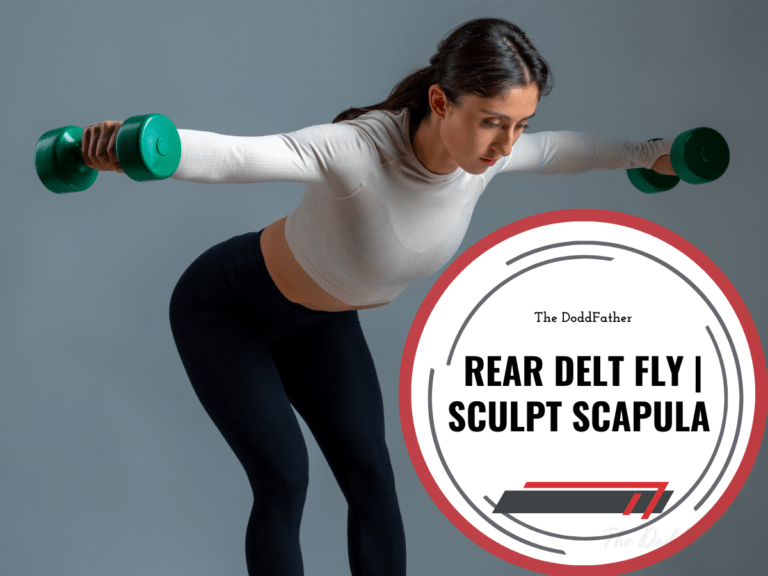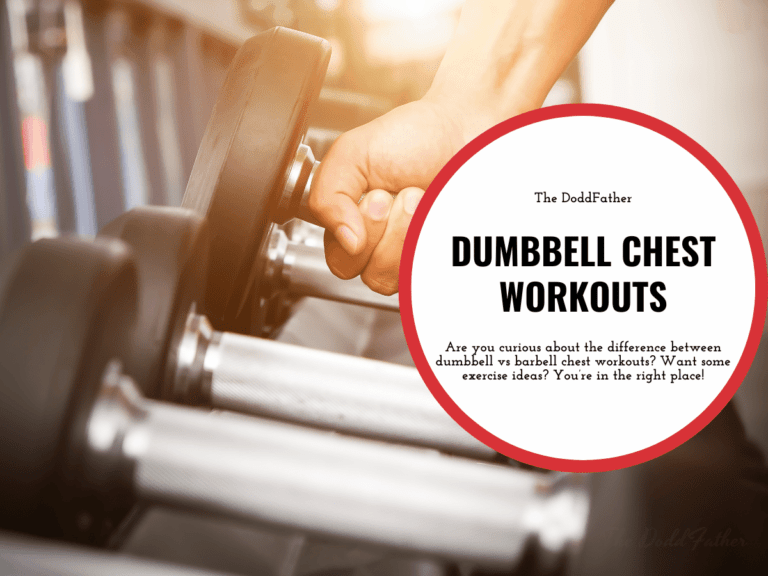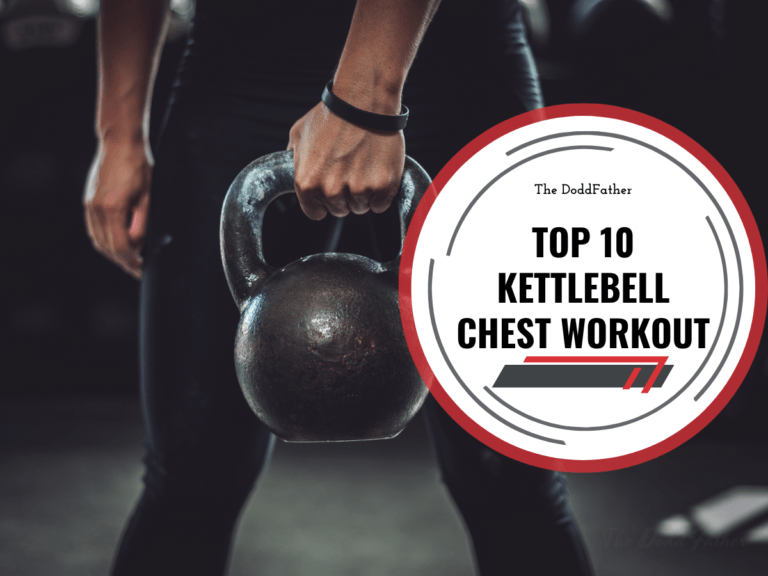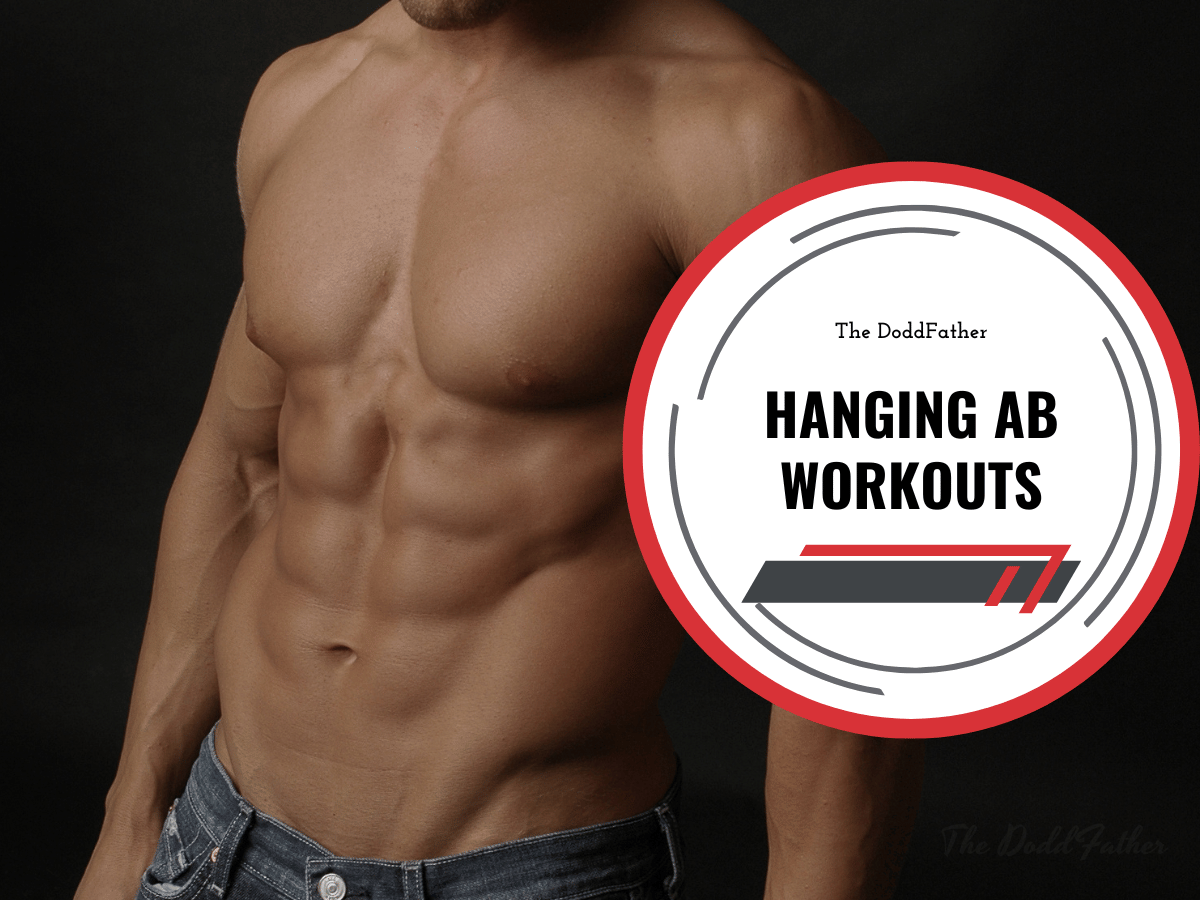
Cody Dodd is a NASM-certified personal trainer and Navy Command Fitness Leader who uses his fitness expertise to write fitness content for The DoddFather. Cody has transformed his physique and confidence by understanding the principles of exercise and fitness.
It all started with a radical fat loss of 55 pounds. From 225 to 170. From a kid who once couldn’t do a pull up, to knocking out 20 pullups in a Navy command competition while floating in the middle of the ocean.
He has a diverse writing and editing background that’s primarily focused on health and fitness, Navy life, and dad life. His work has been featured in Good Dads, as well as Platform Launchers, and Daddying.
Key Highlights
- Hanging ab exercises are a great way to build core strength and definition.
- These exercises can be modified to suit various fitness levels.
- In addition to a strong core, these exercises improve grip strength.
Introduction
The hanging leg raise is a great exercise for your core. There are many hanging core exercises that can help build a strong core! No matter your fitness level, there is a variation for you.
I don’t want you to get bored with it, so I’m going to show you seven amazing hanging ab exercises. These will help shape and strengthen your midsection.
Not only that, it can improve your posture, up your grip strength, and increase your confidence in the gym. Just like with pullups, you’re signaling to yourself and others that you can handle your body weight like a champ.
Most people can’t support themselves suspended in air for long. But you’re not most people! Get ready to improve your ab workout!
7 Effective Hanging Ab Exercises for Sculpted Abs
Hanging exercises are special because they use your body weight against gravity. This extra difficulty makes your muscles work harder and helps them tone faster. These exercises are also incredibly effective to increase your proprioception.
Remember, it is very important to master the proper form. If you don’t, you could get hurt. It is almost always a good idea to talk to a fitness professional. They can help you ensure you are using the proper form and technique.
Once you get the hang of it, you can try these exercises at home on a doorframe pull-up bar or even a tree with a good sturdy limb!
1. Hanging Knee Raises
The hanging knee raise is an important exercise for many hanging ab workouts. It focuses on the abdominal muscles, especially the lower abs, and helps to improve core strength. This is where you start before moving on to hanging leg raises.
To do a hanging knee raise, grab a pull-up bar with your hands in an overhand grip. Make your grip a bit wider than shoulder-width apart. Let your body hang down with your arms fully stretched. Keep your legs together, tighten your core, and lift your knees up towards your chest.
When your knees get close to your chest, hold for a moment and tighten your abdominal muscles. Then, slowly bring your legs back down to the starting position while staying in control. Aim for 10-15 repetitions.
2. Hanging Leg Raise
The hanging leg raise is a step up from the hanging knee raise. In this exercise, you will completely extend your legs. This method works your lower abs and the full rectus abdominis – the six-pack muscle!
Start by holding a pull-up bar with an overhand grip. Your hands should be a bit wider than your shoulders. Let your body hang with your arms straight. Keep your legs straight, tighten your core, and lift your legs until they are level with the floor.
Stay in that position for a moment, squeezing your abs. Then, lower your legs back down slowly. It is important to control your movement. Aim to do 8-12 reps.
3. Hanging Knee Raise Twist
Adding a nice twist to the hanging knee raise recruits your obliques to help with the movement. This change helps build rotational strength and shapes the sides of your abs. It’s important to do exercises in the different movement planes of the body. This one is in the transverse plane.
Start by hanging from a pull-up bar. Use an overhand grip that is a little wider than your shoulders. Keep a slight bend in your elbows and engage your core. Lift your knees toward your chest while twisting your body to one side. Try to bring your knees as close as you can to your elbow.
Take a brief pause at the top, then slowly lower your legs back to the starting position. After that, repeat the move on the other side. Keep alternating sides with each repetition.
4. Hanging Bicycles
This exercise is so fun. It’s great for your whole core, especially the side muscles. It resembles pedaling a bicycle. Depending on your fitness level, you can change the speed and distance you move.
To start, hang from a pull-up bar. Use an overhand grip, a bit wider than your shoulders. Keep your core muscles tight. Lift one knee toward your chest and keep the other leg straight.
While you lower that knee, raise your other knee towards your chest, like you are cycling. Keep doing this pedaling motion for as many times as you want. Make sure to move in a smooth and steady way during the exercise.
5. Hanging Scissor Kicks
Hanging scissors are a great way to work your lower abs and hip flexors. They also make your core stronger and help with your lower body coordination. Keeping your legs straight adds extra challenge, and you’ll feel it fast!
Start by hanging from a pull-up bar with your arms straight. Make sure to engage your core muscles. Raise one leg in front of you as high as possible. Do this without bending your back.
While you lower one leg, lift the other so it looks like scissors moving. Keep your core tight during the exercise. Try for 10-15 repetitions on both sides.
6. Hanging Flutter Kicks
This tough exercise mainly works the lower abs and hip flexors. It needs a lot of core strength and stability. Keeping your spine straight is very important to avoid hurting your lower back.
Grab a pull-up bar using an overhand grip. Your hands should be a little wider than shoulder-width. Let your body hang down freely. Tighten your core muscles and lift your legs up to 90 degrees.
Start doing quick leg lifts, moving your left and right legs alternately. While you do these flutter kicks, make sure to breathe deeply. Keep control of your movements throughout the exercise.
7. Hanging Windshield Wipers
Windshield wipers are an advanced exercise for your abs. Probably the most challenging on this list. They really work your whole core, especially your oblique muscles. Make sure you stay in control while you’re doing this exercise. This helps you get better results and avoid injuries.
First, hang from a pull-up bar with your arms straight down. Use your abdominal muscles to lift your legs until they are level with the ground. This is your starting position.
Next, keep your legs straight and close together. Rotate your torso side to side like windshield wipers. Engage your obliques as you move your legs from one side to the other.
Maximizing Your Hanging Ab Workout
To get the best from your hanging ab workout, pay attention to how you use progressive overload and maintain the proper form. As your core gets stronger, you can make it harder. This can mean adding weights, doing more reps, or choosing tougher exercises.
Being consistent is very important. Doing hanging ab exercises 2-3 times a week will help you improve your core strength, shape, and overall stability. Make sure to listen to your body. Start slowly, then raise the intensity and length of your workouts over time.
Understanding Proper Form and Technique
Maintaining the right form and technique is very important for your hanging ab workouts. It helps you get the best results and avoid injuries. Here are some key tips for keeping proper form:
- Always engage your core muscles during each exercise. This will help keep your body stable and stop unnecessary swinging. Remember to breathe deeply. Don’t hold your breath.
- If you struggle to maintain proper form, think about working with a personal trainer. You could also use ab straps for help. These straps allow you to focus on your core muscles without putting too much strain on your grip.
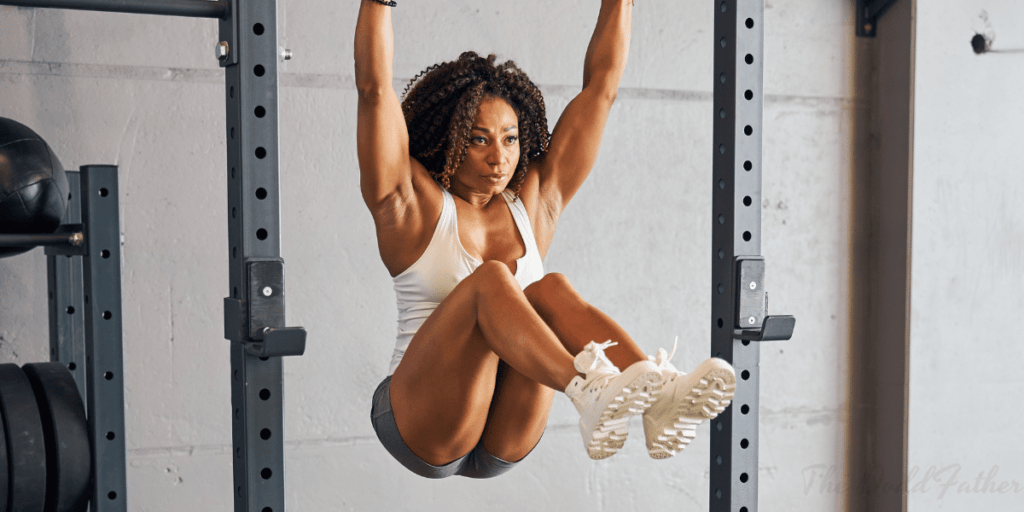
Incorporating Progressive Overload in Your Routine
Progressive overload is a crucial fitness principle. It means slowly making your workouts tougher over time. This idea is key for building muscle strength and size. For instance, if hanging knee raises feel easy, you can switch to hanging leg raises to make it harder.
There are many ways to use progressive overload with hanging ab exercises. One way is to add more repetitions as you get stronger. If you start doing 3 sets of 10 repetitions, try moving to 3 sets of 12 repetitions.
You can also cut down the rest time between sets. As you get better, make rest periods shorter. This makes your muscles work harder and adapt to these tougher demands.
The Science Behind Hanging Ab Workouts
Hanging ab exercises are unique because they work different core muscles at the same time. This helps to strengthen your core better than doing exercises on the ground. The hanging position creates some instability.
This instability requires your core to work harder to stay steady and in control, leading to more muscle activation. When you hang from a bar, it can also help decompress your spine. If you let your body fully extend, it can relieve pressure and improve your posture.
Core Muscles Engaged During Hanging Ab Exercises
Hanging ab exercises work many core muscles better than traditional floor exercises. They mainly target the rectus abdominis, which helps create the famous six-pack look. These exercises also work the internal and external obliques – which help with twisting and bending to the side.
Moreover, hanging ab exercises activate the transverse abdominis. This deep core muscle is important for keeping the spine stable. Because you use many muscle groups, you burn more calories and boost your metabolic rate.
In addition, hanging ab exercises test your grip strength as you hold the bar. This helps strengthen your forearms and improve grip endurance. Better grip strength can help with many other exercises and activities.
P.S. Did you know that a stronger grip strength can actually help you live longer?
Benefits of Strengthening Your Core
A strong core is built by doing exercises like the hanging ab workout. It offers many benefits beyond just looking good. It can help improve athletic performance, posture, balance, and your overall health. When you build a strong core, you not only look better but also enjoy better functional fitness. This makes everyday activities easier.
Having a strong core supports your spine. This may help reduce lower back pain and can prevent injuries. A strong core also helps with better posture, reducing strain on your neck and back. It can even help with digestion and reduce constipation by encouraging regular bowel movements.
Strong abdominal muscles also improve your balance, coordination, and stability. This is especially important as we age, as it helps prevent falls and keeps us mobile. In the end, a strong core can boost your power and performance in sports and other physical activities.
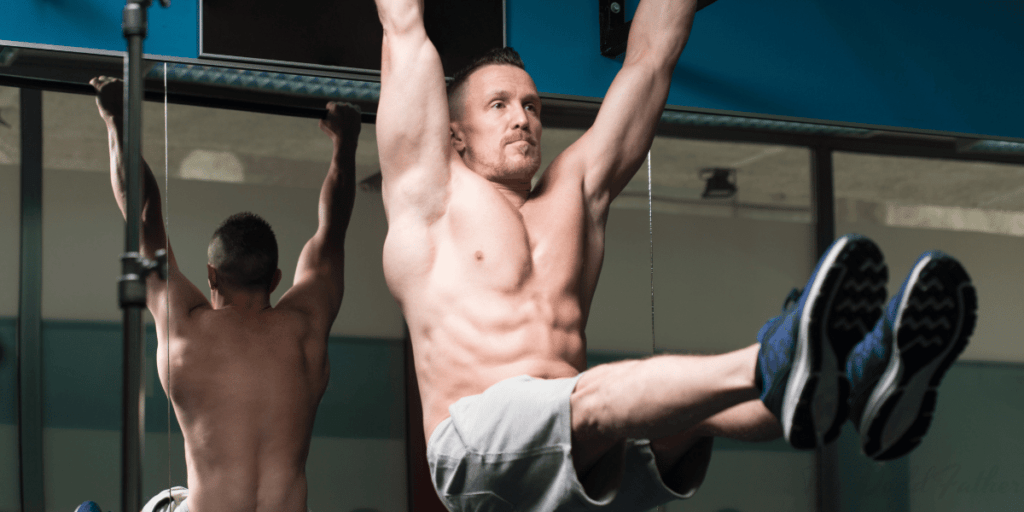
Nutrition Tips for Enhancing Ab Definition
To get well-defined abs, you need to follow a healthy and balanced diet. Abs are made in the kitchen, muscles are built in the gym! Pair your workout routine with food that includes lean protein, whole grains, healthy fats, and lots of fruits and vegetables. This mix will give you energy for your workouts, help your muscles recover, and keep you healthy.
Eating enough protein is important for repairing muscles after exercise and helping them grow. Try to include lean protein options like chicken, fish, beans, and tofu in your meals. Also, remember to drink enough water every day, especially before, during, and after your workouts.
Key Nutrients for Muscle Recovery and Growth
Proper nutrition is very important for muscle recovery and growth. Eating a balanced diet full of key nutrients can help your body repair, rebuild, and strengthen muscle tissue. Protein is especially important because it provides the building blocks needed for muscle repair and growth.
Carbohydrates are also key for muscle recovery. They give you the energy you need for workouts and help refill glycogen stores that get low during exercise. Try to eat complex carbohydrates like brown rice, quinoa, and sweet potatoes. These foods provide energy that lasts longer.
Other important nutrients for muscle recovery and growth are omega-3 fatty acids and antioxidants. Omega-3 fatty acids can reduce inflammation. Antioxidants, found in fruits and vegetables, help protect your muscle cells from damage. Eating foods rich in these nutrients can help keep your muscles healthy.
Hydration and Its Impact on Muscle Tone
Staying hydrated is very important, but many people forget about it. Drinking enough water helps keep your muscles in good shape. When you exercise, you lose fluids by sweating. If you don’t drink enough water, it can make you dehydrated and hurt your workout performance.
Dehydration can cause muscle tiredness, cramps, and less strength. It also slows down the delivery of nutrients to your muscles, which are needed for repair and recovery. Drinking water can help avoid these problems and support your muscles.
Try to drink water all day long. You should drink it before, during, and after your workouts. This is especially important for intense exercises. Staying hydrated will help you get better results from your workouts and keep you healthy overall.
Common Mistakes to Avoid in Hanging Ab Workouts
It’s exciting to try new exercises. However, it’s important to be careful and understand the target muscles with hanging ab workouts. This helps to protect your hip flexors. These muscles lift your legs towards your body, and they can quickly become overworked if you don’t use proper form.
Another mistake people often make with hanging ab exercises is swinging. Some natural movement may happen, but too much swinging makes the exercise less effective. Instead, focus on moving slowly and with purpose. This will help you engage your abdominal muscles and avoid injuries.
Avoiding Overuse of Hip Flexors
When you do hanging ab exercises, you might use your hip flexors too much. These muscles help lift your legs. If you overuse them, it can cause imbalances, pain, and discomfort. I personally struggle with lower crossed syndrome – underactive glutes and overactive hip flexors.
To prevent this, start your movement from your core muscles instead of just your hip flexors. Engage your abs by pulling your lower ribs down towards your pelvis. This way, you can activate your abdominals better.
Don’t swing your legs up quickly. This can put too much pressure on your hip flexors. Focus on smooth and controlled movements. Raise and lower your legs slowly. This will help you work your abdominals more and reduce stress on your hip flexors.
The Risk of Swinging and How to Prevent It
Swinging is a common problem when doing hanging ab exercises. Some swinging might happen, but too much can mess up your form and make the exercises less effective. Swinging usually comes from weak core muscles or bad form.
To stop swinging, concentrate on using your core muscles during each move. Think of tightening your abs like someone is about to hit you in the stomach. This helps you stay steady and move less.
Make sure you’re hanging straight from the bar with your arms fully extended. Don’t bend your elbows or use your upper body to create swinging. By keeping a steady and controlled hanging position, you can work your abs better and reduce unwanted swinging.
Advanced Variations for Seasoned Athletes
For experienced athletes, you can make your hanging ab workouts harder. You can add resistance and new challenges. This will help you push your limits even more.
Always pay attention to your body. Talk to your doctor before changing your workout plan. Also, be sure to warm up properly. This will get your muscles ready for the workout that comes next.
Adding Weights for Increased Resistance
Once you learn the basic hanging ab exercises, adding weight can help you train harder. This makes your muscles work more, which leads to strength training and muscle growth.
You can hold a dumbbell or weight plate between your feet when doing hanging leg raises or knee raises. This extra weight makes the exercise harder and more effective. Start with a lighter weight, and then increase it as you get stronger.
It’s important to focus on proper form instead of lifting too much weight. Using too much weight can hurt you. If you’re new to weighted exercises, try other ways to make your workout harder. You can do more repetitions or take shorter breaks.
Combining Hanging Ab Exercises with Other Workouts
Combining hanging ab exercises with upper body workouts is a smart way to make the most of your training time. You can try doing hanging leg raises along with pull-ups or chin-ups.
This mix works several muscle groups and helps improve your strength. You can effectively train your core and upper body in one session. Start with a few sets of each exercise and slowly increase them as you get stronger.
Pay attention to your body and take rest days when needed. This will help you avoid overtraining and lower your chances of getting injured. Feel free to try different combinations until you find what feels best for you.
Conclusion
In conclusion, a good hanging ab workout plan can help you get toned abs and strengthen your core muscles. Focus on using proper form, slowly increase the intensity, and eat essential nutrients to get the best results. Be sure to avoid common mistakes, such as overworking your hip flexors and swinging too much.
If you are an advanced athlete, think about using weights or mixing up exercises for more challenge. It’s important to stay consistent and patient. Results may show at different times, but sticking to your regular workouts will help you make progress.
It’s never a bad idea to talk to a fitness professional for tips and changes based on your fitness level and goals. Start your hanging ab workout journey today for a stronger core and a fitter midsection!
Frequently Asked Questions
How Often Should I Perform Hanging Ab Workouts?
The number of times you do your hanging ab workouts should match your fitness level and exercise routine. It’s usually best to start with 2-3 sessions each week. This gives your muscles time to rest and grow. Also, using proper form is very important.
Can Hanging Ab Exercises Help Reduce Belly Fat?
While hanging ab exercises are good for making your core stronger, they cannot directly reduce belly fat. If anyone claims an exercise can spot reduce fat, they are lying to you. However, these exercises may help burn more calories and increase your metabolism. Over time, this can lead to losing fat overall.
What Safety Precautions Should I Take During Hanging Ab Workouts?
If you have any health conditions, talk to a doctor or a personal trainer before starting hanging ab workouts. Make sure the bar is safe and use the right technique to avoid injuries. Pay attention to your body and stop if you feel pain.
Are There Any Alternatives If I Can’t Perform Hanging Exercises?
If hanging exercises don’t work for you, there are other options. Captain’s chair leg raises would have to be number one for me. Talk to a physical therapist or a certified trainer. They can suggest changes and different exercises that can help improve your core strength. This is very important if you have lower back problems.
How Long Does It Take to See Results from Hanging Ab Workouts?
The time to see results from hanging ab workouts can change based on different things. These include your genetics, body type, and how hard you train. If you train regularly and eat well, you will notice a change in your core. This can help you reach your fitness goals.
Tips for Beginners Starting Their Hanging Ab Workout Journey
For beginners, try easier versions of hanging exercises. You can bend your knees or use a chair for support. Focus on slowly building your core strength. Also, work on getting comfortable in the starting position. Follow these workout tips and improve step by step over time.
